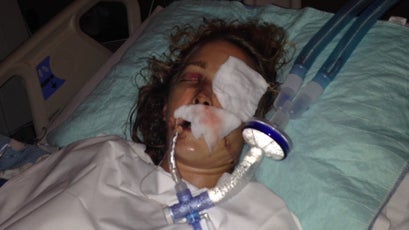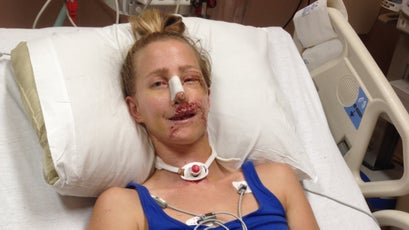As told to Luke Whelan
I had been dating my boyfriend, Kennett, for a year and a half, and he was the one who really got me into bike racing. I entered it pretty quickly. I was working in the bike industry, writing copy for bike shop websites, then I started racing bikes in the spring of 2014.
At that point, I was living in Boulder with Kennett, and we had moved into an apartment with his brother and his brother’s girlfriend. We had a new puppy. We didn’t own a car. We bike-commuted everywhere, so we were on the bike together daily in some fashion or another.
I decided to do a longer-distance triathlon in mid-November. October 18 was basically the last big ride before my race. I was going out to do over 100 miles. For me, it was really a mental training ride. Kennett and the other guys went up into the mountains for a climb, and I was staying on the flats because I was on my triathlon bike, which would mimic what my race would be like.
I was maybe 30-some miles in, traveling on U.S. 36. There’s a road that intersects with 36 on a wide-open downhill fairly early on. I was going down the hill, and this red Fiat came up from the east, went past the stop sign and straight into the road, and stopped in the shoulder lane of traffic. He wasn’t fully out into U.S. 36 where he would have had a car hit him, necessarily, but he was directly in the line of all the cyclists.
I was going about 35 miles an hour, and I hit the brakes as soon as I saw him—I only had seconds to react. I skidded 50 feet. My rear wheel skidded out from underneath me. I thought I was just going to hit the pavement, but I hit the car probably going about 10 miles hour. I don’t remember impact. I have a very fuzzy vision of being lifted into the ambulance and the one EMT saying to the other EMT, “Her face has peeled off.”
Apparently, your body will dissociate, and so I don’t have any memories except for that one, but I was awake. They were trying to keep me calm, obviously. I think I asked why there was so much blood.
These stories that come out in the newspaper often blame the cyclist, and the cyclist often does not have a chance to submit a witness statement, because, if we’re going to be frank, the cyclist will often be the one who dies.
I crashed on Saturday, and my first memories are on Thursday. They had put me in a sedated coma. I couldn’t talk, so I spent several days just writing notes to people. Nobody sat down and listed off my injuries to me. At one point, I was writing to my mom, “I was so lucky. I can’t believe I didn’t break a bone in my body!” And my mom had this look, and she said, “You broke every bone in your face.”
My head and my shoulder had gone through the window. The whole left side of my face was broken. My skin was ripped back from my lip all the way back to behind my ear on the left side. I tore my shoulder muscle. I broke my eye socket, nose, cheekbone, and jaw. When I say I broke them, they were shattered; they needed to be reconstructed. Every four hours, they were putting leeches on my upper lip to draw blood—my lip was dying, so that was a way to keep the skin alive. I had around 700 stitches. I had to do neurological testing after the crash, and the neurologist said I had PTSD. Subconsciously, I was going through a lot more than I realized.
I spent 11 days in intensive care, and I improved a lot every day. I had goals every day. By February, I was pretty much fine physically, but to this day I still deal with the emotional repercussions of the crash.
But when I was in the hospital, there was a newspaper article about my crash, and it . [After its initial report, the newspaper interviewed Perr and followed up with a .] I read through the witness statements, and the driver had lied. He said that there were black cars that prohibited him from moving out of my way. Nobody had asked me to submit a witness statement. These stories that come out in the newspaper often blame the cyclist, and the cyclist often does not have a chance to submit a witness statement, because, to be frank, the cyclist will often be the one who dies.
I submitted a witness statement anyway. I have so many things that I wish the police could have looked into. Other cars had to put on their brakes and get out of the way. Another cyclist who was only a few feet behind me had to swerve into the oncoming lane of traffic to avoid hitting that car. It was pretty obvious that the driver was in an area he shouldn’t have been in.
The district attorney and I met, and she said that if she could have, she would have charged it as reckless driving, but it’s really hard to prove and there’s a good chance he would have gotten off without punishment. Charging him with careless driving—one step below reckless—almost guaranteed that he would get charged and sentenced.
And he did. He pled guilty to careless driving resulting in injury. He got a $1,000 fine, 200 hours of community service, and four points on his license, and he had to take a driver’s class, but he got to keep his license. I didn’t go to the sentencing because it would have been to traumatic to be in the courtroom while the driver got sentenced so lightly..
In Colorado, my case of careless driving causing serious bodily injury doesn’t fall under the Crime Victims’ Rights Act [which protects victims of crime and ensures they are kept informed about the criminal justice process]. The district attorney and the legal system do not have to keep me in the loop at all. But they did. They put my case in a yellow folder, which was designated for people who fall under the Crime Victims’ Rights Act. There were several people within the legal system who really did watch out for me.
Kennett told me that he had asked me to marry him that first night I was in the hospital. That still makes me way more emotional than thinking about when he asked me again, when I could remember. I have bipolar II, so one of the major concerns was how the crash was going to impact my emotional state. That had always been something that made me question whether Kennett would want to be with me. So here was this event that almost guaranteed to impact my emotions in a negative way, and he was willing to be there for that. That was huge. I lucked out big-time; he’s the greatest guy ever. Some of the time, we just had to suffer through it, but we were going through it together. We got married at the county clerk’s office in 2015.
There’s nothing about my situation that makes me different from what many other people have been through. But I’m willing to be the face for what happens to people. If I can, I will confront people who are driving unsafely. Kennett chased down a bus a year ago. If they apologize, I won’t call the cops on them. A lot of people are really aggressive. They’re like, “Don’t touch me!” with their four-ton SUV behind them.
I have this feel-good story because I’m back and I’m training and I’m a professional as of last summer. I think when I talk to other people, it can come off as happily ever after. And, honestly, in my case, sometimes I do feel it that way. My bones are all repaired. I didn’t lose my eyesight—that’s a really big one. It was really close to my jugular, really close to my eyes. There were a lot of things that could have gone wrong. But that’s not the case for a lot of people—not everyone survives or makes a good recovery. Even when a crash victim does make a full physical recovery like I did, something had been taken from them. The joy that they used to get from riding and their sense of justice may never be the same. My scars show the physical trauma that I went through, but fail to capture the emotional damage that was done, which is largely irreparable.
is a writer and professional triathlete.




